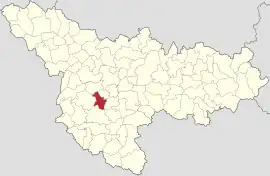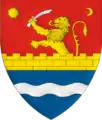Parța | |
|---|---|
 Timiș River in Parța | |
 Location in Timiș County | |
 Parța Location in Romania | |
| Coordinates: 45°38′N 21°8′E / 45.633°N 21.133°E | |
| Country | Romania |
| County | Timiș |
| Government | |
| • Mayor (2020–2024) | Daniel Drăgan[1] (PNL) |
| Area | 61.37 km2 (23.70 sq mi) |
| Elevation | 86 m (282 ft) |
| Population (2021-12-01)[3] | 2,351 |
| • Density | 38/km2 (99/sq mi) |
| Time zone | EET/EEST (UTC+2/+3) |
| Postal code | 307396 |
| Vehicle reg. | TM |
| Website | www |
Parța (Hungarian: Parác; German: Paratz; Serbian: Парац, romanized: Parac) is a commune in Timiș County, Romania. It is composed of a single village, Parța, and was part of Șag commune until 2004.[4]
History
Parța was first documented in 1334 as Parkas, and in 1417 the settlement of Maraz, with town (market) status, is recorded near Parța.[2] At the conscription (census) carried out in 1717 by the Austrians, after the conquest of Banat, the settlement had 84 houses and was called Paraz.[2]
In 1878, during the regularization of the Timiș River, traces of a Neolithic settlement on three levels were discovered here, in which pottery specific to the Vinča culture was found. The first systematic excavations of the site began in 1931 and were completed only in 1985.[5] Over the course of five decades, the following have been discovered here: two Neolithic sanctuaries, one with monumental statues, relocated and restored in Timișoara's National Museum of Banat, another overlapping the first one from which only one altar has been preserved, household shrines or altars, about 150 houses and complexes and four dwellings with 4–5 rooms, some of which have a suspended floor or an upper floor.[6]
Demographics
Parța had a population of 2,172 inhabitants at the 2011 census, up 24% from the 2002 census. Most inhabitants are Romanians (80.43%), larger minorities being represented by Hungarians (5.94%), Roma (4.65%), Serbs (2.03%) and Germans (1.98%). For 4.6% of the population, ethnicity is unknown.[7] By religion, most inhabitants are Orthodox (50.18%), but there are also minorities of Greek Catholics (21.59%), Roman Catholics (8.56%), Pentecostals (8.47%), Serbian Orthodox (1.43%) and Baptists (1.15%). For 4.74% of the population, religious affiliation is unknown.[8]
| Census[9] | Ethnic composition | |||||
|---|---|---|---|---|---|---|
| Year | Population | Romanians | Hungarians | Germans | Roma | Serbs |
| 1880 | 2,226 | 1,455 | 160 | 290 | – | 297 |
| 1890 | 2,744 | 1,543 | 411 | 489 | – | 281 |
| 1900 | 2,813 | 1,444 | 521 | 541 | – | 284 |
| 1910 | 2,739 | 1,333 | 543 | 559 | – | 252 |
| 1920 | 2,761 | 1,346 | 567 | 539 | – | – |
| 1930 | 2,633 | 1,498 | 367 | 527 | 22 | 194 |
| 1941 | 2,404 | 1,310 | 448 | 438 | – | – |
| 1956 | 2,021 | – | – | – | – | – |
| 1966 | 1,935 | 1,136 | 341 | 277 | 27 | 138 |
| 1977 | 2,034 | 1,358 | 277 | 208 | 60 | 120 |
| 1992 | 1,420 | 1,066 | 150 | 78 | 56 | 65 |
| 2002 | 1,752 | 1,412 | 129 | 61 | 88 | 59 |
| 2011 | 2,172 | 1,747 | 129 | 43 | 101 | 44 |
References
- ↑ "Results of the 2020 local elections". Central Electoral Bureau. Retrieved 16 June 2021.
- 1 2 3 "Statutul comunei Parța" (PDF). Primăria comunei Parța. p. 3.
- ↑ "Populaţia rezidentă după grupa de vârstă, pe județe și municipii, orașe, comune, la 1 decembrie 2021" (XLS). National Institute of Statistics.
- ↑ "Lege nr. 84 din 5 aprilie 2004 pentru înființarea unor comune". Portal Legislativ.
- ↑ "The Neolithic Sanctuary of Parța". Romanian Cultural Institute.
- ↑ Lazarovici, Gheorghe; Merlini, Marco; Lazarovici, Magda. "Șantierul arheologic Parța. Casa Cerbului, 1-15 iulie 2005". The Global Prehistory Consortium.
- 1 2 "Tab8. Populația stabilă după etnie – județe, municipii, orașe, comune". Institutul Național de Statistică.
- 1 2 "Tab13. Populația stabilă după religie – județe, municipii, orașe, comune". Institutul Național de Statistică.
- ↑ Varga, E. Árpád. "Temes megye településeinek etnikai (anyanyelvi/nemzetiségi) adatai 1880-2002" (PDF).
